Anders Bruno Liljefors
a plastic sculpture, in collaboration with Tarkett, Ronneby, Sweden ca 1969.
Steel profiles, height ca 72 cm.
Minor wear.
Provenance
Bought directly from the artist, thence by descent.
Exhibitions
Porslinsmuseum, the sculpture was shown in an retrospective exhibition of Anders Bruno Liljefors, Gustavsberg, Sweden 2011.
Literature
Gösta Arvidsson, "Keramikens revolutionär, Anders Bruno Liljefors", Carlsson bokförlag 2011, see pp 139-141.
Anders Bruno Liljefors was one of four artists who were invited to put up art in Tarkett's new plastic factory for plastic tubes, which was inaugurated in 1969. With the help of waste material, Liljefors made a number of improvised sculptures of plastic. For the opening of the factory he made six sculptures and later he made additional plastic sculptures on Tarkett. He had three colors to choose from; maroon, gray and white, the colors in which the tubes were made.
Designer
Ceramicist and painter Anders Bruno Liljefors studied at the Royal Academy of Fine Arts from 1945 to 1947. He worked at Gustavsberg's Studio during the periods 1947-53 and 1955-57, as well as at his own studios in Roslagen and in Blekinge. Liljefors started at the Gustavsberg factory as a handyman, but his talent was quickly noticed by Wilhelm Kåge, who, after just a few weeks, provided Liljefors with his own studio in the Studio where he primarily worked with stoneware. Soon, Liljefors had his own turner, Dan Malmborg, and together they developed the rustic grey-green stoneware that became his breakthrough. His first solo exhibition was at Nordiska Kompaniet in Stockholm in 1952. It was a success, with most pieces sold. In 1955, he conducted the first experimental trials with sand casting, which attracted significant media attention when presented in the factory's shop on Birger Jarlsgatan in Stockholm. Writers were surprised, puzzled, delighted, and sceptical; terms like "Ceramic Neo-Brutalism" were coined, some saw new possibilities within architecture, while others were less impressed by the collection. These primitive and bold forms were nonetheless groundbreaking, and the Swedish stoneware tradition was thereby energised to develop in new directions. In 1961, Liljefors received the first Kåge Scholarship for his "strongly personal and refreshingly innovative style". During the 1960s, he carried out around 15 public decorations, ranging from minor decorations to entire walls.
Read more















































